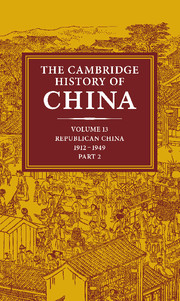Book contents
- Frontmatter
- 1 Introduction: perspectives on modern China's History
- 2 China's international relations 1911–1931
- 3 Nationalist China during the Nanking decade 1927–1937
- 4 The Communist movement 1927–1937
- 5 The agrarian system
- 6 Peasant movements
- 7 The development of local government
- 8 The growth of the academic community 1912–1949
- 9 Literary trends: the road to revolution 1927–1949
- 10 Japanese aggression and China's international position 1931–1949
- 11 Nationalist China during the Sino-Japanese War 1937–1945
- 12 The Chinese Communist movement during the Sino-Japanese War 1937–1945
- 13 The KMT-CCP conflict 1945–1949
- 14 Mao Tse-Tung's thought to 1949
- Bibliographical Essays
- Bibliography
- Conversion table: pinyin to Wade-Giles
- Index
- Republican China - physical features">
- References
9 - Literary trends: the road to revolution 1927–1949
Published online by Cambridge University Press: 28 March 2008
- Frontmatter
- 1 Introduction: perspectives on modern China's History
- 2 China's international relations 1911–1931
- 3 Nationalist China during the Nanking decade 1927–1937
- 4 The Communist movement 1927–1937
- 5 The agrarian system
- 6 Peasant movements
- 7 The development of local government
- 8 The growth of the academic community 1912–1949
- 9 Literary trends: the road to revolution 1927–1949
- 10 Japanese aggression and China's international position 1931–1949
- 11 Nationalist China during the Sino-Japanese War 1937–1945
- 12 The Chinese Communist movement during the Sino-Japanese War 1937–1945
- 13 The KMT-CCP conflict 1945–1949
- 14 Mao Tse-Tung's thought to 1949
- Bibliographical Essays
- Bibliography
- Conversion table: pinyin to Wade-Giles
- Index
- Republican China - physical features">
- References
Summary
LITERATURE OF THE THIRTIES 1927–37
In its broadest connotation, the term ‘May Fourth literature’ (Wu-ssu wen-hsueh) encompasses at least two decades – the 1920s and 1930s. Most Western scholars have adopted this vague definition and equated, in fact, the May Fourth era with the modern phase of Chinese literature, to be followed by the Yenan (1942–9) and Communist (since 1949) phases. This facile division, while clearly juxtaposing the basic differences between the individualistic thrust of May Fourth literature and the collective orientation of Communist literature, seems to gloss over other areas. Most Chinese and Japanese scholars agree that the literary euphoria of the May Fourth period had gradually dissipated itself by the late 1920s, to be replaced by a more ‘mature’ phase of literary creativity in the early 1930s. The term ‘literature of the thirties’ (san-shih nien-tai wen-hsueh) thus refers essentially to works produced in the decade from 1927 to 1937.
In this perspective, the thirties represented a crucial phase in the history of modern Chinese literature. Inheriting the May Fourth legacy, writers of the thirties were able to attain a depth of vision and a sophisticated technique which the early May Fourth practitioners of New Literature failed to achieve (the major exception being, of course, Lu Hsun). This artistic depth was accompanied by a sharpened consciousness of the deepening social and political crisis as the spectre of Japanese invasion loomed large in the north and the Communist Revolution gathered new momentum in its rural headquarters in Kiangsi. It was in this momentous decade, therefore, that art became inextricably enmeshed with politics and the romantic temper of the early twenties gave way to some sombre reassessments of the writer's social conscience.
Keywords
- Type
- Chapter
- Information
- The Cambridge History of China , pp. 421 - 491Publisher: Cambridge University PressPrint publication year: 1986
References
- 1
- Cited by

